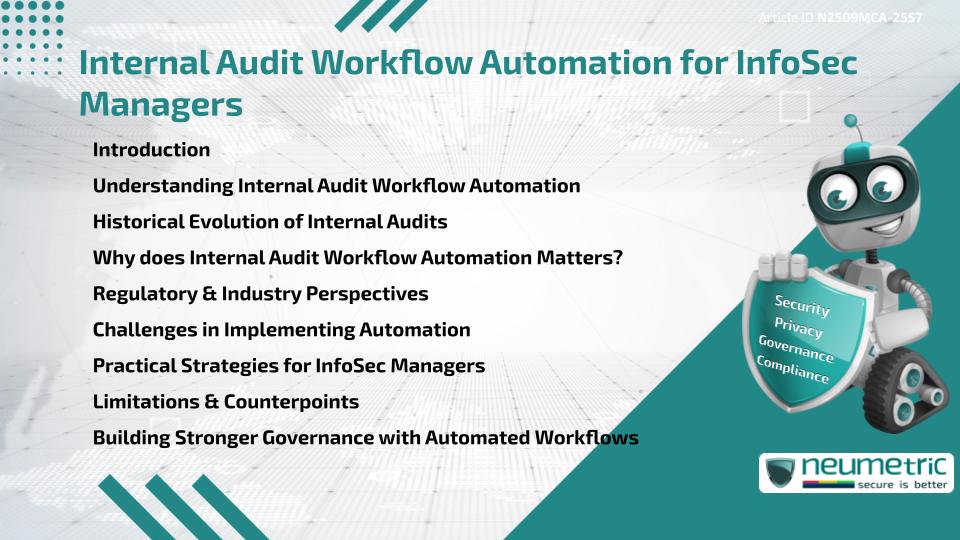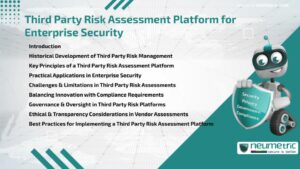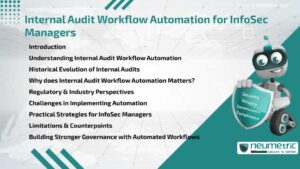Table of Contents
ToggleIntroduction
Internal Audit Workflow Automation is transforming how Information Security [InfoSec] managers oversee Governance & Compliance. By automating repetitive Audit tasks such as Scheduling, Evidence collection & Reporting, organisations can reduce human error, accelerate Compliance Reports & strengthen Oversight. Internal Audit Workflow Automation ensures Audits are consistent, efficient & aligned with Regulatory Standards, ultimately supporting Business Objectives & Customer Expectations while enhancing Cybersecurity Strategies.
Understanding Internal Audit Workflow Automation
Internal Audit Workflow Automation refers to the use of Policies, Technologies & Processes that streamline traditional Audit activities. Instead of manually tracking Audit Engagements, InfoSec managers can rely on automated platforms to schedule Audits, collect data & flag Non-Conformities.
Automation improves Transparency by maintaining secure Audit Trails & enabling Continuous Monitoring & Improvement. It also integrates easily with Risk Management systems, making it easier for InfoSec managers to demonstrate adherence to Ethical & Regulatory Standards.
Historical Evolution of Internal Audits
Historically, internal Audits were paper-based & heavily reliant on manual processes. Audit teams spent weeks Preparing, collecting Evidence & drafting Compliance Reports. As organisations grew more complex, the need for digital tools emerged.
The shift to digital Auditing systems improved Data Accessibility but still required significant manual effort. Internal Audit Workflow Automation builds on this evolution by fully digitising Scheduling, Reporting & Risk Assessments, thus freeing up Auditors to focus on high-value analysis.
Why does Internal Audit Workflow Automation Matters?
Internal Audit Workflow Automation is critical for several reasons:
- Efficiency: Automated Scheduling & Evidence collection reduce time spent on repetitive tasks.
- Risk Reduction: Continuous Monitoring ensures early detection of Security Gaps.
- Compliance: Automation supports adherence to frameworks such as ISO 27001 Certification, SOC 2 Certification & GDPR Compliance.
- Transparency: Detailed Audit Trails strengthen Accountability.
For InfoSec managers, automation means more accurate Audits, better resource allocation & stronger alignment with Business Operations.
Regulatory & Industry Perspectives
Regulatory bodies encourage the use of automation to ensure consistency & reliability in Compliance Reports. For example, ISO 27001 Certification requires documentation & Evidence that can be streamlined through automated workflows. Similarly, SOC 2 Audits & HIPAA demand strict Audit Trails & timely Reporting.
Industry benchmarks increasingly highlight automation as a Best Practice, especially as organisations face greater Regulatory Standards & increased complexity in Systems, Processes & Services.
Challenges in Implementing Automation
Despite its benefits, Internal Audit Workflow Automation comes with challenges:
- Integration Issues: Legacy systems may not connect seamlessly with automated platforms.
- Cost: Initial investments in Audit Software can be significant.
- Change Management: Employees may resist automation due to fear of redundancy.
- Complex Configurations: Tailoring automation tools to specific Audit processes requires expertise.
InfoSec managers must balance these challenges with long-term efficiency gains.
Practical Strategies for InfoSec Managers
To implement Internal Audit Workflow Automation effectively, InfoSec managers can:
- Conduct Gap Analysis to identify manual bottlenecks.
- Choose platforms that integrate with Risk Assessments & Data Security systems.
- Apply Continuous Monitoring & Improvement to Audit workflows.
- Train Employees through structured Training Programs on automated tools.
- Collaborate with Certification Bodies for Compliance guidance.
These strategies ensure smoother adoption while maintaining strong Governance Standards.
Limitations & Counterpoints
Some experts caution that automation may create overreliance on tools, potentially overlooking nuanced human judgement. In addition, complex Audits involving Ethical Standards or unusual scenarios may still require manual oversight.
Others note that poorly configured automation can lead to Compliance Reports filled with inaccurate data, creating further Risk. Nevertheless, when combined with human expertise, automation provides unmatched consistency & scalability.
Building Stronger Governance with Automated Workflows
Internal Audit Workflow Automation is more than just a tool-it is a Governance enabler. By automating tasks, InfoSec managers can demonstrate Transparency & Accountability, reduce Risks & ensure adherence to Regulatory Standards.
When implemented strategically, automation not only strengthens Security Frameworks but also builds lasting Customer Trust by protecting Confidential Data & maintaining robust Oversight.
Takeaways
- Internal Audit Workflow Automation streamlines repetitive tasks for InfoSec managers.
- Automation reduces Risks, improves Efficiency & strengthens Compliance.
- Regulatory Standards such as ISO 27001 & SOC 2 support automated Audits.
- Challenges include integration, cost & resistance to change.
- A balanced approach combines automation with human oversight.
FAQ
What is Internal Audit Workflow Automation?
It is the use of automated tools to streamline Audit tasks like Scheduling, Evidence collection & Reporting.
Why is Internal Audit Workflow Automation important for InfoSec managers?
It improves Efficiency, reduces Risks, supports Compliance & strengthens Governance Standards.
What challenges exist in implementing Internal Audit Workflow Automation?
Integration with legacy systems, cost, Employee resistance & complex configurations.
Does automation replace Auditors entirely?
No, automation supports Auditors by handling repetitive tasks, while human expertise remains essential.
Which frameworks benefit from Internal Audit Workflow Automation?
ISO 27001 Certification, SOC 2 Certification & GDPR Compliance all benefit from automated Audit Trails & Reporting.
How can InfoSec managers start with automation?
By conducting Gap Analysis, selecting suitable platforms, training Employees & ensuring Continuous Monitoring & Improvement.
Can automation ensure absolute Compliance?
No System guarantees absolute Compliance, but Automation greatly improves Accuracy, Transparency & Efficiency.
Need help for Security, Privacy, Governance & VAPT?
Neumetric provides organisations the necessary help to achieve their Cybersecurity, Compliance, Governance, Privacy, Certifications & Pentesting needs.
Organisations & Businesses, specifically those which provide SaaS & AI Solutions in the Fintech, BFSI & other regulated sectors, usually need a Cybersecurity Partner for meeting & maintaining the ongoing Security & Privacy needs & requirements of their Enterprise Clients & Privacy conscious Customers.
SOC 2, ISO 27001, ISO 42001, NIST, HIPAA, HECVAT, EU GDPR are some of the Frameworks that are served by Fusion – a SaaS, multimodular, multitenant, centralised, automated, Cybersecurity & Compliance Management system.
Neumetric also provides Expert Services for technical security which covers VAPT for Web Applications, APIs, iOS & Android Mobile Apps, Security Testing for AWS & other Cloud Environments & Cloud Infrastructure & other similar scopes.
Reach out to us by Email or filling out the Contact Form…





